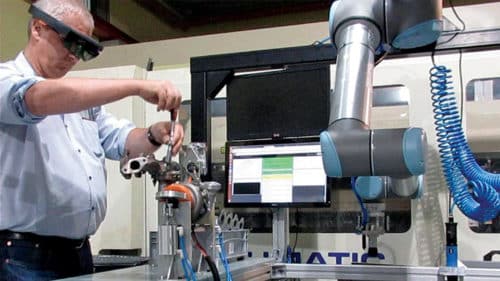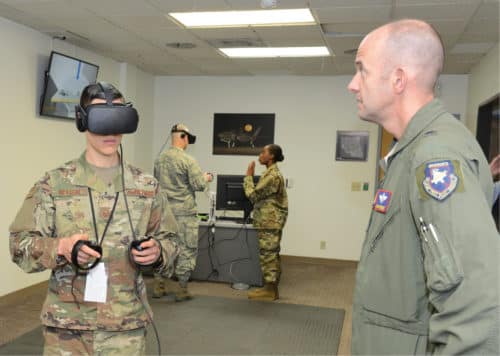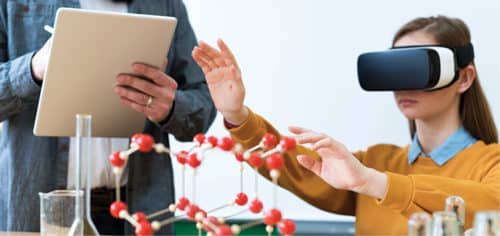One of the biggest benefits in an augmented reality (AR)- and virtual reality (VR)-enabled environment is the ability to innovate products and services in a completely new way.

Adoption of augmented reality (AR) and virtual reality (VR) technologies in education, healthcare and industries has led a new foundation for digital transformation. Students and doctors can learn in new ways by experiencing 3D views of their designs. Employees can interact with machines with the help of AR- and VR-guided training materials. The entertainment industry is also exploring AR and VR content for an exciting cinematic experience. These experiences will further improve with advancements in AR- and VR-based technologies and assistive tools.
Many big manufacturing and automotive industries are deploying AR and VR platforms to achieve higher efficiency and error-free training. For example, Blue Star has applied an AR/VR platform for inspection and manufacturing operations. And, Royal Enfield has applied it for marketing purposes. Similarly, Volvo’s manufacturing plants have deployed such a platform for engine quality control and assurance.
Earlier, training new operators on complex inspection procedures took five weeks, which added to the overall cost. Now, using Vuforia AR experience, operators can quickly recall the most up-to-date configurations in 3D to ease the burden of sorting through stacks of paper, creating gains in productivity, quality control and overall process efficiency.
In the Industry 4.0 world, youth with skills and competencies in AR and VR will have a unique advantage in the future job market. AR and VR comprehensive sessions will enable enterprises discover how these technologies can change the process, reduce cost of training and product design.
VR, AR and mixed reality (MR) can replicate the real environment using advanced processing, computing, sensing and display technology. One of the biggest benefits in a VR- and AR-enabled environment is the ability to innovate products and services in a completely new way.
Role of AI and ML in AR-VR integration
Artificial intelligence (AI) and machine learning (ML) technologies help reduce human error rates through AR and VR simulations of dangerous tasks and environments. India’s skill development, training and learning space will create thousands of jobs opportunities in gaming, immersive advertising, creative media, movies, and AR and VR. Centres of excellence (CoEs) in this area will create thousands of job opportunities in the gaming and creative media spaces.
ML enables the machine to learn from the various tasks it performs to improve itself. AI ensures that the machine applies that learning algorithm best based on different situations. For example, a system could be trained using deep learning to recognise more complex scenarios or components. A camera’s view of parts in an engine could suggest a repair to the technician, with instructions pinpointed on the image.
Also, an AR display that uses AI image recognition can streamline complex maintenance in aviation.
AI-based personalised shopping is another example that utilises VR devices.
AR and ML can be used together to solve business challenges and revolutionise everyday lives. AR harnesses the ability of ML to learn and remember imagery. Similarly, AR apps created for mobiles utilise AI and ML capabilities of smartphones.
Immersive head-mounted displays (HMDs) are primarily used to experience AR and VR. AR HMDs drive enterprise usage as hands-free tools for business process improvement and training.
Realty industry
Housing.com has launched a first-of-its-kind innovative VR-based solution called RealtyVision 2.0 for 3D presentation of real-estate projects. The portable product offers 3D walkthrough support, and can be controlled from both the buyer’s as well as the seller’s end. It reflects the consumer’s real-time journey via touchscreen. This feature enables the seller to guide, explain and navigate during the digital tour through convenient remote/pointer-based interactions.
The state-of-the-art technological solution offering integrated 3D experience works without an Internet connection, easily facilitating customer visits. It allows the builder to sync all data through the cloud, and update fresh information and new projects as per need.
Ravi Bhushan, group CPTO, Housing.com, PropTiger.com and Makaan.com, says, “VR is moving from being a novelty to a necessity in the real-estate sector. Homebuyers, developers and real-estate agents are demanding a better and more efficient way of discovering and showcasing properties. We believe that this innovation will empower consumers to make smarter purchasing decisions more efficiently.”
Manufacturing industry
3D AR and VR platforms have applications in multiple domains for developing real-time simulations that can create virtual environments. Such platforms are transforming the way OEMs execute designing, marketing, training, autonomous driving and human-machine interactions. These enable OEMs to innovate, deploy and test human-machine interfaces (HMIs) for the next generation of vehicles through a real-time 3D-simulated environment.
OEMs are witnessing the ability to conceptualise autonomy to advanced levels of safety and smartness without undergoing physical testing to keep their business costs down. Customers can also configure or experience in VR before physical cars are available in retail.
Security services
AR and VR can solve complex problems of the digitising world. With constant innovation and integration of AR/VR, Indian defence systems can enhance their strategy and use these technologies for such visual information as horizon line, aircraft speed and altitude. Anumukonda Ramesh, country head – India, Unity Technologies, says, “Defense and PSU sectors are one of the biggest users of simulation and visualisation for training, learning and product designing.”

AR military systems can test any weaponry before use; for example, ARC4 connects to military satellites and drones as well as highlights dangers and threats in AR mode.
VR, AR and MR require new computing platform designs to replicate the real environment. These use advanced processing, sensing and display technology, and are ideal for defence sector applications to gain experience of dangerous environments from the convenience of a training room. Such applications can put trainees in different situations and environments for teaching awareness and upskilling to provide valuable experiences.
Retail industry
AR and VR have the potential to revolutionise customer experience and drive revenues by individualising retailer offers and enabling customers to visualise products in different settings. Retailers can also enhance the understanding of information through advanced graphical visualisation and simulation technologies.
Pilots and implementation examples include VR tours by Tesco, Alibaba’s full VR shopping experience, Adidas’ VR videos to promote its outdoor clothing collection and FR Tech-iLUK for personalised styling. With AR-enabled platforms, buyers can also interact with the product(s) they want to buy to better understand them and explore their functionalities.
Business processes
If such AR displays as smart glasses become more common, identity detection can enrich everyday conversations by providing details such as projects a colleague is working on. Immersive telepresence enhancements come by adding elements of VR, AR and AI to improve the collaborative experience.
Indrajit Belgundi, general manager, Client Solutions Group, says, “AR/VR will bring more on-site learning and creativity to the workplace. On-site training opportunities and the ability to access data in real time will give the workforce freedom to do their best work untethered from the workplace. Further, employees will be able to collaborate as if they are all physically working together, bringing everyone into one virtual environment.”
Education and entertainment industries
The education sector has become the most funded industry, bringing in new-age education for the next generation in the form of app-based learning and smart classes. STEAM (Science, Technology, Engineering, Arts and Mathematics) education offers new-age experiential learning for students age six onwards, in the form of robotic kits, AI programming, AR/VR interactive classes, the Internet of Things (IoT) applications, 3D printing, STEAM activities and training programs, among others. AR and VR apps in the education sector add an interactive audio-visual factor to the e-learning process.

Platform such as Augment Education are great for making presentations, modelling and 3D designing, for constructing various e-learning materials using objects and animating them employing various shapes and actions.
Another example is SignAloud Gloves tool for students with impairments. The tool allows students to communicate using sign language in a VR environment and translates the same into human speech.
2D, 3D, 4D and interactive AR/VR content used for gaming and films can be created through flexible and high-performance end-to-end development platforms. India has a huge potential in Industry 4.0 in terms of evolving capabilities for creating digital content, ranging from animation, gaming, VFX, AR and VR.
Healthcare
AR and VR together with AI can educate the next generation of professionals in life-threatening and responsible jobs such as doctors, firemen, factory workers, pilots and the like. Doctors can go through countless virtual scenarios of operations without putting a single life in danger. Firemen teams can go through the worst cases, pilots can bring back the plane’s latitude to the haven or emergency landing, medical teams can save people’s lives from traffic accidents and natural disasters.
AR and VR have positively impacted the healthcare industry just like the Internet of Things (IoT), AI and ML. There are several examples of AR and VR in the healthcare sector, from training and surgery guidance to organ-mapping in real time that help doctors avoid errors.
Future scope
AR or VR will help in the transformation of industries across the board. These technologies will continue to help achieve better designs and faster time-to-market through immersive training tools offering simulations and scenarios in a secure, risk-free environment.
Recent developments in technology that have enhanced VR capabilities are deep learning to foster real-time image and speech recognition, increased availability and reduced cost of local processing and storage, network bandwidth expansion with 5G, richer data streams and availability of AI in the cloud.
5G mobile network technology provides an opportunity to accelerate the adoption of AR and VR. Gartner expects that implementation of 5G and AR/VR in stores will transform shopping experiences and the entire product management cycle of brands.
Both AR and VR combined with AI and ML will create a better future, and take industries and businesses to an entirely new level.







